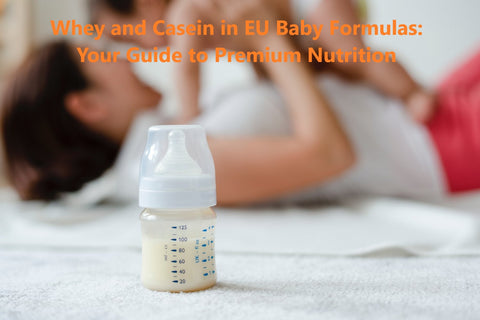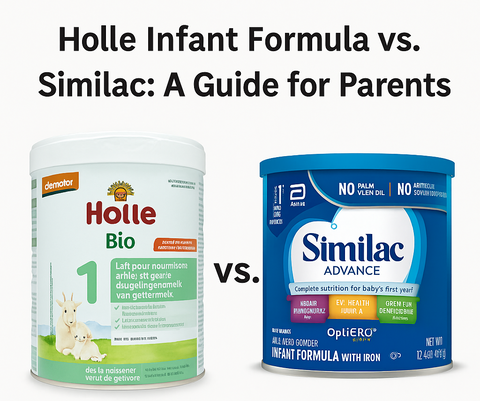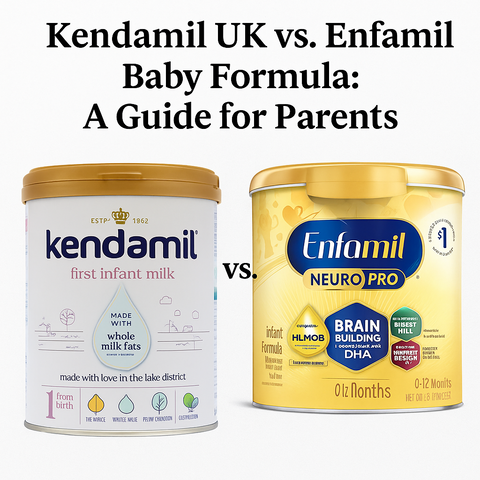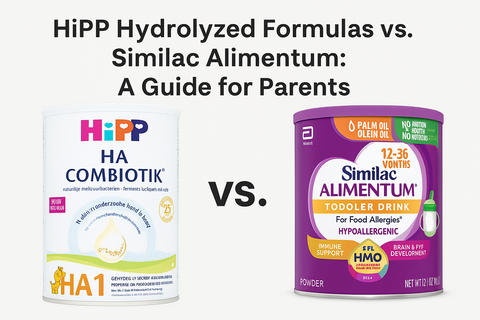HiPP Infant Formula vs. Similac: A Guide for Parents
Choosing the right infant formula is a significant decision, and with so many options, it can feel overwhelming. Two leading brands, HiPP Infant Formula (crafted for the European market) and Similac (a trusted US name), stand out for their quality and nutritional focus. For parents searching for HiPP Formula in the US, understanding how these European formulas compare to Similac is key. This guide compares HiPP and Similac, highlighting differences like stricter European Food Safety Authority (EFSA) regulations, organic certifications, iron levels, and the impact of Operation Stork Speed. We’ll help you find the best formula for your baby’s needs.
Why Compare HiPP and Similac?
HiPP and Similac are prominent in the infant formula market, each offering unique benefits that make them worth comparing.

HiPP, a German family-run brand founded over a century ago, is a pioneer in organic baby food and formula. Renowned for sustainability and organic farming, HiPP uses high-quality, organic ingredients free from GMOs, synthetic pesticides, and antibiotics. Popular products like HiPP Combiotic Dutch Formula, HiPP Combiotic German Formula, and HiPP Goat Formula adhere to EFSA standards, providing tailored nutrition for various developmental stages.

Similac, produced by Abbott Nutrition since 1925, is a trusted US formula brand. With options like Similac 360 Total Care, Pro-Advance, and Sensitive, Similac meets diverse nutritional needs while adhering to U.S. Food and Drug Administration (FDA) standards. Widely available, it’s a go-to for American parents seeking formula.
While both brands prioritize infant health, HiPP’s organic, EFSA-regulated formulas contrast with Similac’s FDA-compliant range. Initiatives like Operation Stork Speed highlight gaps in US formula safety, making this comparison vital for parents exploring HiPP Formula in the USA.
Similarities Between HiPP and Similac
HiPP and Similac share several features that make them popular, reflecting their commitment to infant nutrition:
-
High-Quality Ingredients: Both use carefully selected ingredients to support growth. HiPP sources organic skimmed milk, while Similac uses nonfat milk and whey protein.
-
Specialized Formula Options: HiPP offers HiPP Comfort Formula for digestion and HiPP HA Formula for allergies. Similac provides Sensitive, Total Comfort, and Alimentum for fussiness, lactose sensitivity, and allergies.
-
Prebiotics: Both include prebiotics (GOS and FOS in HiPP, FOS in some Similac formulas) to promote gut health.
-
DHA and ARA: Both incorporate DHA and ARA for brain and eye development, sourced from organic oils (HiPP) or processed sources (Similac).
-
Essential Vitamins and Minerals: Both are fortified with vital nutrients for healthy development.
-
Eco-Friendly Packaging: Both use recyclable cans to maintain freshness and reduce waste.
Comparison Chart: Shared Features
|
Feature |
HiPP |
Similac |
|---|---|---|
|
High-Quality Ingredients |
Yes |
Yes |
|
Specialized Formula Options |
Yes |
Yes |
|
Prebiotics |
Yes |
Yes |
|
DHA & ARA |
Yes |
Yes |
|
Essential Vitamins & Minerals |
Yes |
Yes |
|
Eco-Friendly Packaging |
Yes |
Yes |
Key Differences Between HiPP and Similac
While both brands excel, their differences stem from regulatory standards, ingredients, formulation stages, and initiatives like Operation Stork Speed. Let’s explore these to help you choose between HiPP Formula, carried by Organic Formula Shop, and Similac.
1. Regulatory Standards: EFSA vs. FDA
The primary difference lies in the regulatory frameworks:
-
HiPP (EFSA Standards):

Formulas like HiPP Combiotic Dutch Formula and HiPP Goat Formula follow EFSA and EU organic regulations, requiring:
-
- No synthetic pesticides, fertilizers, or GMOs.
- Strict limits on contaminants and additives.
- Comprehensive safety and nutritional testing.
- Holistic animal welfare, including outdoor grazing.
-
Similac (FDA Standards): Similac adheres to FDA and USDA standards, which are less stringent. For example:
-
- FDA permits synthetic nutrients and additives banned in the EU.
- Organic certifications allow limited pasture access and potential pesticide overspray.
- Testing is thorough but less extensive than EU protocols.
Key Takeaway: EFSA’s stricter standards ensure HiPP’s superior purity, making HiPP Formula USA a premium choice compared to Similac.
2. Organic Certification: European vs. American
EU Organic standards differ significantly compared to the US standards:
-
HiPP (European Organic): HiPP’s formulas, like HiPP Combiotic German Formula, meet stringent EU Organic standards, banning synthetic hormones, antibiotics, and cross-contamination. Farms prioritize soil health and animal welfare.
-
Similac (American Organic): Only some Similac formulas (e.g., Similac Organic) are USDA-certified organic, but standards allow flexibility in pasture access and trace GMOs from manufacturing, which is less rigorous than EU standards.
Why It Matters: HiPP’s organic certification appeals to parents seeking purity, while Similac suits those prioritizing accessibility.
3. Operation Stork Speed: Addressing US Formula Safety

Launched on March 18, 2025, by Health and Human Services Secretary Robert F. Kennedy Jr., Operation Stork Speed aims to enhance US infant formula safety, nutritional quality, and availability. Prompted by the 2022 formula shortage and concerns about contaminants like arsenic and lead, it includes a nutrient review (first since 1998), increased heavy metal testing, and more transparent labeling. This highlights gaps in FDA oversight compared to EFSA’s protocols, giving HiPP an edge in purity.
4. Ingredients: Probiotics, Carbohydrates, and Oils
HiPP and Similac differ in their ingredient profiles:
-
Probiotics and Prebiotics:
-
- HiPP: Includes prebiotics (GOS, FOS) and probiotics (Lactobacillus fermentum, Bifidobacterium infantis) in formulas like HiPP Comfort Formula for gut health.
- Similac: Includes prebiotics (FOS) in some formulas (e.g., 360 Total Care) but lacks probiotics, offering less digestive support.
-
Carbohydrates:
-
- HiPP: Uses organic lactose, mimicking breast milk. Some formulas include starch or maltodextrin for thickness.
- Similac: Uses lactose in some formulas (e.g., Pro-Advance) but includes corn syrup solids or high fructose corn syrup in others (e.g., Sensitive), which may cause blood sugar fluctuations.
-
Vegetable Oils:
-
- HiPP: Uses organic palm, sunflower, and rapeseed oils in HiPP Dutch Goat Formula, sourced sustainably.
- Similac: Includes palm olein, soy, coconut, and high oleic safflower oils, with palm oil potentially linked to digestive issues.
5. Iron Levels: A Critical Consideration for Newborns
Newborns have iron reserves for the first 4-6 months, making excessive iron potentially harmful, causing digestive issues or microbiome imbalances. EFSA-regulated HiPP formulas, like HiPP Combiotic Dutch Stage 1, have low iron (0.5-0.7 mg/100ml) for newborns. FDA-regulated Similac formulas (0-12 months) have higher iron levels (1.8 mg/100ml), which may be excessive for younger infants, potentially causing discomfort. EFSA’s precision gives HiPP Formula an advantage.
6. Formulation Stages: Tailored Nutrition
HiPP and Similac approach developmental stages differently:
-
HiPP Stages (Up to Six Stages):
-
- Stage Pre (0-6 months): Low iron (0.5-0.7 mg/100ml), no starch, for premature or low-birth-weight babies (e.g., HiPP Combiotic Dutch Stage Pre).
- Stage 1 (0-6 months): Low iron (0.5-0.7 mg/100ml), no starch, for term newborns (e.g., HiPP Combiotic Dutch Stage 1, HiPP Goat Stage 1).
- Stage 2 (6-12 months): Higher iron (1.0-1.2 mg/100ml) for weaning (e.g., HiPP Combiotic German Stage 2).
- Stage 3 (12-24 months): Adjusted toddler nutrients (e.g., HiPP Combiotic Dutch Stage 3).
- Stage 4 (24+ months): For young children with higher energy needs (e.g., HiPP Combiotic Dutch Stage 4).
- Specialized All-Age Formulas: Includes HiPP Comfort Formula, HiPP Anti-Reflux Formula, and HiPP HA Formula.
-
Similac Stages (Single Stage):
-
- Infant Formula (0-12 months): Consistent iron (1.8 mg/100ml), potentially high for newborns (e.g., 360 Total Care, Pro-Advance).
- Toddler Formula: Go & Grow for 12-36 months, less specialized than HiPP’s stages.
Environmental and Sustainability Practices
HiPP excels in sustainability, sourcing organic skimmed milk from farms prioritize soil health and animal welfare. It minimizes palm oil use, uses recyclable packaging, and follows EFSA’s eco-conscious standards. Similac uses recyclable cans and some organic options but relies on palm oil and less sustainable sourcing, with broader manufacturing limiting its environmental scope.
Why It Matters: HiPP’s sustainability appeals to eco-conscious parents seeking, while Similac suits those prioritizing affordability.
Conclusion: Why HiPP Stands Out
Both HiPP and Similac offer high-quality formulas, but HiPP’s organic composition, EFSA compliance, and stage-specific formulations make it a premium choice for parents exploring HiPP Formula. Similac’s affordability and specialized options are strong, but its use of corn syrup solids and palm oil and less rigorous FDA oversight place it behind HiPP.
HiPP’s probiotic-rich formulas and diverse options (including goat milk and hypoallergenic) are top-tier for parents seeking premium, organic nutrition. Similac is ideal for budget-conscious families with specific needs, but HiPP leads in quality.
Order your HiPP Formula Here. ***We ship every order (for free!) in just 2 to 4 business days, faster than anyone else, anywhere in the US! ***
Contact
Contact our dedicated customer support team for expert advice and guidance tailored to your baby's needs. They have earned hundreds of 5-star reviews from our customers, helping you to provide the best nutrition for your little one. Contact us here or shoot us an email at support@organicformulashop.com. We're here to help!
Disclaimer: The information provided in this blog reflects the current product details from HiPP and Similac as of the publication date. While we strive to provide accurate and up-to-date information based on official brand sources, we have not independently verified all specifics. Product formulations, ingredients, packaging, and other details may change without prior notice. We recommend checking the latest information and consulting healthcare professionals or pediatricians before deciding on infant formula feeding.




